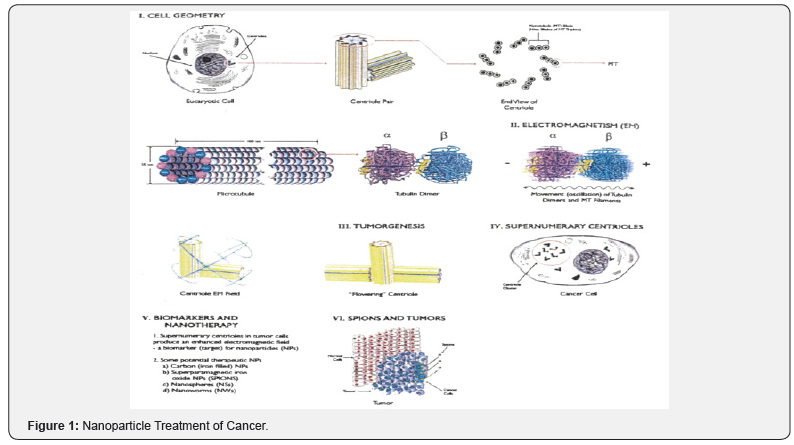Nanoparticle Treatment of Cancer
Ronald L Huston
Mechanical and Materials Engineering, University of Cincinnati, USA
Submission: October 12, 2018;Published: November 20, 2018
*Corresponding author: Ronald L Huston, Mechanical and Materials Engineering, University of Cincinnati, Cincinnati, OH 45221-0072, USA
How to cite this article:Ronald L Huston. Nanoparticle Treatment of Cancer. Curr Trends Biomedical Eng & Biosci. 2018; 17(2): 555959. DOI:10.19080/CTBEB.2018.17.555959.
Mini Review
The accompanying figure outlines elements of cell biology which can go awry during cell duplication and division [1,2]. If a duplication problem occurs, the cell often dies. But on occasion the problem can lead to uncontrolled duplication, tumorigenesis, and even cancer [3]. The duplication problem occurs with geometric distortion or over-duplication of centrioles – small perpendicular hollow cylinders lying adjacent to the cell nucleus [4]. The Figure 1 shows how this over-duplication occurs, a cancer cell is created and then how the resulting cancerous tumor can be treated by nanoparticles.

The proposed nanoparticles are superparamagnetic iron oxide particles (SPIONs) which are attracted to the magnetic field surrounding the tumors. The SPIONs can carry toxins which will kill the tumor cells [5], or alternatively by vibration can thermally kill the tumor cells.
References
- Huston RL (2014) On Centrioles, Microtubules, and Cellular Electromagnetism. Journal of Nanotechnology in Engineering and Medicine 5(3): 031003.
- Huston RL (2016) A Review of Electromagnetic Activity in Cellular Mechanics. Advances in Bioscience and Biotechnology 7(9): 360-371.
- Huston RL (2016) A Review of Centriole Activity, and Wrongful Activity, during Cell Division. Advances in Bioscience and Biotechnology 7(3): 169-182.
- Huston RL (2016) Mechanics of Centriole Microtubules. Advances in Bioscience and Biotechnology 7(6): 266-277.
- Huston RL (2017) Electromagnetic Enhancement of Cancer Cells as Biomarkers for Nano Theranostics. Nanotechnology: Nanomedicine & Nanobiotechnology 4(2): 1-5.






























